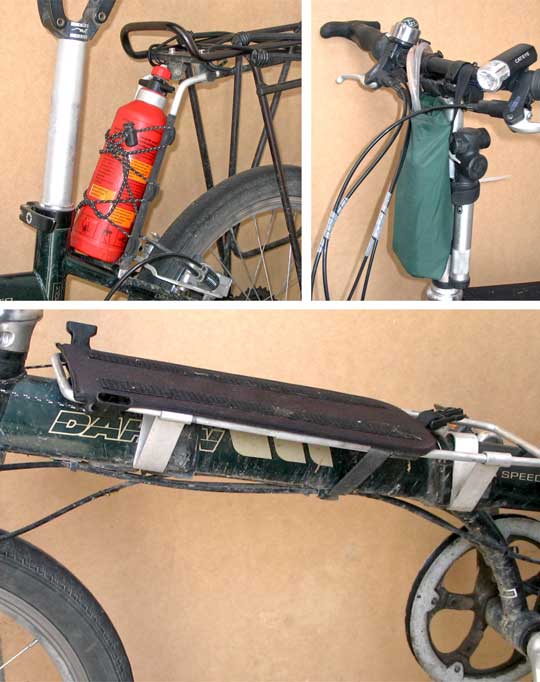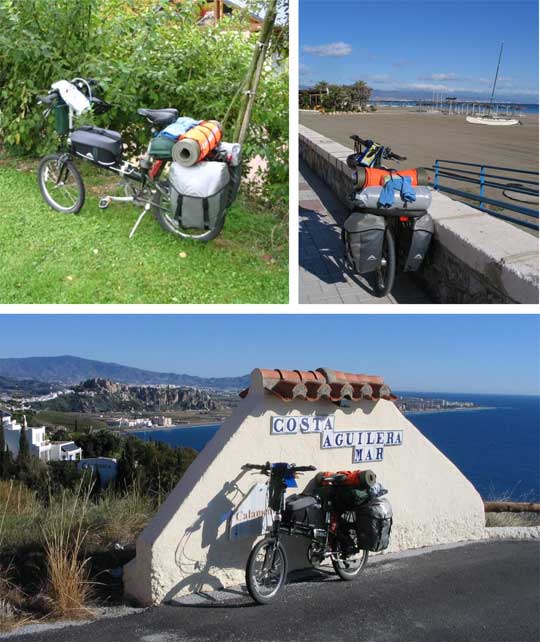
By Phil Chappell
First
published 8 August 2009
At the beginning of September 2008 I set out on a Dahon Speed TR folding bike with the sole objective of heading south for the winter. Over the following nine months I cycled from Leicester to Dover via Salisbury, by ferry to Calais, around western France, around the Portuguese and Spanish coast, back into France then north from the Rhone valley to Belgium to back to England As the intention was to be as self reliant as possible the bike was loaded with everything thought necessary for lightweight camping.
The choice of bike was accidental really: I had been searching the Internet for touring bikes and came across the Speed TR at Dahon's web site. Advertised as suitable for long distance touring, I was intrigued and not a little sceptical. On the basis that it should be capable of short tours in the UK at least, it was ordered from a UK dealer. Shortly afterwards the opportunity for a long tour arose.
On first examining the bike's suitability, two challenges arose: there were no attachments for fitting water bottles or pump and the rack mounts on the rear stays were lower than normal. The former was overcome by simply strapping a home made bag to the handlebars to hold a Platypus water bottle and strapping a pump to the handlebar stem with nylon cable ties. The latter had a couple of possible solutions: use Dahon's own racks or modify a standard rack. Eventually a Tourtec Expedition rack was chosen as it's a proven design and also allows the panniers to sit lower, thus keeping the top platform unobstructed. In order to fit the Dahon, longer front rack stays had to be made from 11mm aluminium rod but this was a fairly straightforward procedure. Finally, an A5 clipboard strapped to the handlebars made a crude map holder.

Modifications made to the basic bike: new rack stays, water carrier and crossbar mounted rack
A short ride to a nearby campsite for the weekend gave me the opportunity to test the configuration and find out how the bike behaved when fully loaded. It turned into quite a frightening experience due to rainy conditions and a dangerously light front wheel. In order to clear the feet, the panniers have to be placed quite a way back, almost overhanging the rear axle. Although I'd packed the heavy items towards the front of the rack the front wheel was still too light and had very little grip on slippery surfaces. After gingerly wending my way home the problem of distributing the weight was tackled.
The option of using front rack and panniers was considered but rejected for two reasons: the more space you have the more you'll carry, and I was concerned they would have a detrimental effect on steering. Whilst sitting on the bike pondering it became apparent that the very low crossbar and the width between the pedals created a space that could be utilised. After a bit of measuring and experimenting it was found that a standard rear rack pack would sit nicely there. A rack was made from aluminium rod and bar to mount on the crossbar and a rack pack fitted. The theory was that if heavy items such as camera, toolkit etc. were kept in the rack-pack it would counterbalance the panniers due to the longer lever arm in relation to the back axle. Time had now ran out so the theory would have to be tested on the tour.
The first weakness became apparent when tackling steepish hills. The handlebar hinge and catch do not seem strong enough to pull back on, therefore all pedal pressure has to come from legs and torso. The first maintenance involved adjusting the gears slightly and tightening up the handle bar hinge catch. The sliding catch which is held by two screws needs slight play otherwise it becomes very difficult to open. Apart from that everything else was fine, the balance of the bike was good, the centre pack did not interfere unduly with the legs although the centre rack started to wobble after a while due to its amateur construction. The rear rack tended to sway very slightly probably due to the low front mounting. On bumpy roads the bottom of the pannier pressed the hub gear cable release button and occasionally released it. The only other concern was the availability of spares for the hydraulic rim brakes abroad, so these were purchased whilst in England. Most people seemed to believe that folding bikes are somehow inferior to standard bikes. The various comments I had whilst starting out were:
"You'll never get far on that shopping bike!"
"Don't your legs have to go round more?"
Slight play in the front wheel was noted and found to be a slightly loose head bearing. Although easy to readjust, the single bolt in the head bearing clamp was felt to be insufficient. A back injury in Bayeux meant readjusting riding position and the large degree of adjustment in the handlebars stem proved useful. As the bike is only available in one size frame a good amount of flexibility in seat and handlebar position is essential. The low crossbar proved particularly convenient at this time and was preferable in general for mounting the bike when fully loaded. The stand proved totally inadequate and needs to be stronger with a more rigid mounting.The combination of hub gear and derailleur was superb. When an occasional forced stop could often mean being caught in the wrong gear, it was a simple matter to change down using the hub gear prior to starting off. There is a noticeably large step between second and third gears on the derailleur but his can be evened out using the hub gears.
The climbs through the Pyrenees into northern Spain would have been easier with a lower gear. The difference in gear ratios between the Speed TR and 'proper' touring bikes was particularly noticeable when climbing Mont Igueldo near San Sebastian with two other cycle tourists on Koga-Miyatas.
Although a large step was noted between the second and third derailleur this could be minimized to a large extent by using the hub gears.
I decided to cut across northern Spain by train due to a rapid deterioration in weather. Rather than fold the bike I chose to use regional trains which accept bikes. When one of the trains broke down and was replaced by an express, the conductor initially refused to let me on. After being made aware of both the circumstances and the fact the bike could be folded, I was allowed on and able to make the remainder of the journey in comfort. It was noted that the folding pedals make little difference, and were later found a distinct disadvantage when using them to prop the bike up using the kerb, the newer removable pedals might have been better.
The long steep hills in Cabo de Gata, south western Spain, again highlighted the inadequate gear range and weakness in the handlebar assembly but showed the excellent stopping capabilities of the hydraulic rim brakes. The brakes proved difficult to adjust as the adjustment screw is obscured by the brake lever. The Allen keys on my multi-tool were too long to fit, a normal cranked Allen key might have made life easier. The handlebar extensions, although small, allowed enough variation in riding position to reduce the effect of pressure on the hands during long journeys. The improvised water carrier proved very versatile as bought bottles of water (or any other drink) could be simply dropped into the bag when the Platypus was empty. Along the south coast of Spain the bike often aroused interest and had its photo taken many times. The fact it was capable of touring was now undeniable, although many people still found it remarkable I had cycled from England on it.

The loaded bike at various stages in the journey
The bike was absolutely faultless on the return through France to England. Apart from the general maintenance of cleaning and lubricating the gears and chain, nothing further needed to be done. It was also interesting to see how comments changed the further I traveled. When I set out people thought I was slightly mad to choose a folding bike. By the time I had reached southern Spain the general view was one of amazement and people taking photos of the loaded bike and myself. When I returned to England it turned into more a sense of disbelief. Wherever I was, the bike invariably provoked comment and proved a useful aid in socialising. The only low point was having a pannier stolen at a campsite just outside Cambridge. As there was nothing of value in it and I was only a days ride from home it meant throwing away unessential items to free sufficient space in the remaining pannier. Considering I had spent almost nine months on the road without any trouble whatsoever, it was disappointing rather than inconvenient that it should happen so close to journeys end.
Disadvantages
Small 20 inch wheels affected slightly more by rough roads than
larger 26inch
or 700c wheels.
Spares for hydraulic rim brakes hard to come by except in specialised
shops in large cities.
Single frame size not ideal for all riders.
Gear range insufficient for very steep hills whilst carrying touring
equipment.
Single chain wheel and seven cog cassette means chain alignment not
ideal at the highest and lowest gears.
Lack of braze-ons means improvisation necessary to fit water bottles,
pump etc.
Standard racks need modifying.
Low rack mounts means rack can sway slightly when loaded.
Short wheelbase puts rear load too far back over rear axle. Weight on
front essential.
Supplied stand inadequate.
Folding pedals offer little advantage.
Handlebar stem folding mechanism too insubstantial for touring.
People think you're mad touring on a folding bike.
Advantages
Small
wheels proved strong with no damage to rims or spokes despite some
severe hits.
Hydraulic rim brakes very effective. Could possibly be replaced with
cantilevers as a last resort.
Large amount of adjustment in handlebar position meant a reasonable
riding position can usually be found.
Ergonomic saddle as comfortable as can be expected. ( I didn't use
cycling shorts as there seemed little point in having an ergonomic
saddle and then covering it with a large pad).
Low single crossbar means getting on a loaded bike is easy compared to
lifting leg over rack and panniers or standard crossbar.
Hub/derailleur combination is very flexible and proved very reliable.
Only required adjusting once in the nine months.
The necessity to improvise can produce useful results.
Increases transport choice.
People think you're mad touring on a folding bike.
The interest shown in touring on a folder helped meeting people.
The tyres and brake pads lasted the whole trip (just!).
The A5 clipboard was one of the most versatile map holders I've had. Not only would it carry any size and shape of map but guide books, bags of nuts and sunglasses. Waterproofing was achieved by dropping a plastic bag over it.
The use of a bag attached to the handlebars to hold a water container also proved very versatile.
Test
reports
| Folding
Society home page
Copyright ©2009 Phil Chappell
Last modified 23/9/2008